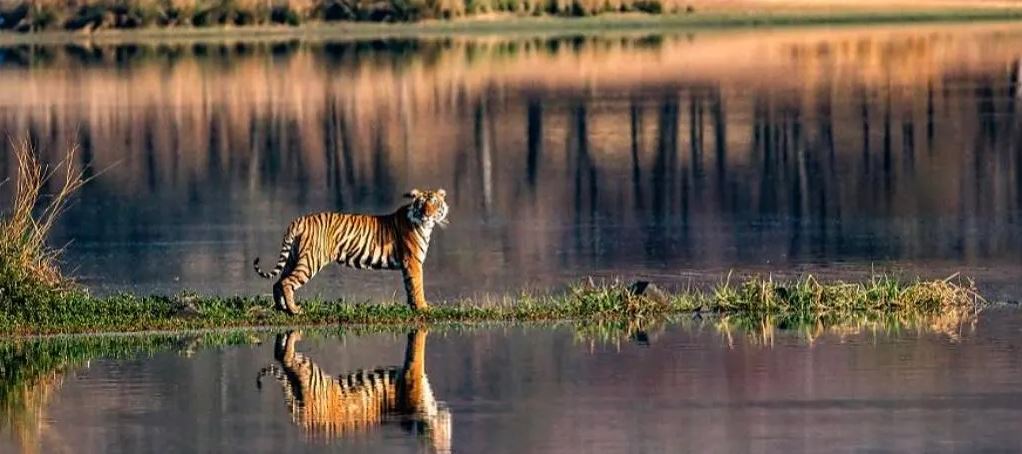An Overview of Ranthambore National Park
Located in the arid landscapes of Rajasthan, Ranthambore National Park boasts the Bengal tiger as its star attraction. With the forest experiencing dry conditions for over eight months annually, the likelihood of encountering these majestic creatures is notably higher compared to other Indian national parks.
Initially serving as the private hunting grounds of the Jaipur royal family, Ranthambore underwent a significant transformation in 1955 when it was designated as the ‘Sawai Madhopur Sanctuary’. The cessation of game permits came about in 1973 with its inclusion in Project Tiger, leading to the relocation of 12 villages nestled within its borders. Subsequently, in 1980, a portion covering 282.03 sq. km. of the sanctuary’s core area was declared a national park to bolster conservation efforts.
Within Ranthambore National Park lie remnants of a bygone era, with scattered structures evoking a sense of history. The park features numerous water bodies, serving as vital refuges for its inhabitants during scorching summer months. Perched atop a hill, a grand fort lends its name to the park, overlooking its expansive domain. Tigers here are known for their boldness, often hunting in full view of human spectators. Their fearless demeanor extends to daytime sightings, as they exhibit minimal apprehension toward vehicles carrying visitors.
Unleash Your Curiosity about Ranthambore with the Following Reasons
Spotting Tigers and Other Wildlife is Easy
Experience the thrill of a safari through Ranthambore National Park, where you can witness the majestic Bengal tigers and graceful leopards in their natural habitat, soaking up the winter sun as they roam freely. In addition to the impressive tiger population, the park is teeming with a variety of wildlife including chital, nilgai, wild boar, sambar, rufous-tailed hare, toddy cats, sloth bears, mugger crocodiles, and many other fascinating species.
Landscapes are Worth Admiration
Ranthambore National Park boasts a distinctive and picturesque landscape, blending dry deciduous forests, serene lakes, and historic remnants. Its terrain is adorned with rocky outcrops, cliffs, and hills, setting a breathtaking scene for wildlife expeditions. Among these rocky terrains lie ancient ruins, notably the Ranthambore Fort, adding to the park’s allure. This unique topography creates a perfect environment for a rich array of wildlife, including tigers, leopards, hyenas, sloth bears, deer, and an abundance of bird species.
The Ranthambore Fort Adds a Historical Dose
Ranthambore National Park derives its name from the ancient Ranthambore Fort, dating back to the 10th century, nestled atop a hill within the park boundaries. Originally under the authority of the Chauhan dynasty, the fort was later captured by the Delhi Sultanate in the 13th century. Today, it stands as a magnificent relic of the past amidst the wilderness. Recognized as one of the Hill Forts of Rajasthan, the Ranthambore Fort holds the prestigious status of being a UNESCO World Heritage Site in India.
Temples and Scenic Lakes also Coexists with Ranthambore’s Wildlife
Ranthambore National Park isn’t merely a wildlife sanctuary; it also harbours ancient temples and religious sites ripe for exploration. These sacred sites offer a glimpse into the rich cultural and religious tapestry of the region. Among the notable temples are Trinetra Ganesh Temple, Kala Gaura Bhairav Temple, Mahaveerji Temple, and Chamatkar Temple, all located in close proximity to the national park. Additionally, the area boasts picturesque lakes and water bodies such as Padam Talao, Rajbagh Talao, Malik Talao, and Surwal Lake, providing a serene respite from the hustle and bustle. These temple and lake excursions offer visitors a chance to pause their wildlife safaris and delve into the spiritual and natural splendour of Ranthambore.
Birdwatching at its Best
Ranthambore emerges as a haven for bird enthusiasts, boasting a diverse avian population of over 300 species. Birdwatching tours offer visitors the opportunity to observe rare and exotic birds in their natural habitat. Among the park’s stunning avifauna are flamingos, flycatchers, waterfowl, sarus cranes, grey hornbills, cormorants, serpent eagles, bronzed-winged jacanas, painted spurfowl, and nightjars, among others. Particularly near the park’s vast water bodies, a multitude of migratory birds congregate, adding to the spectacle.
